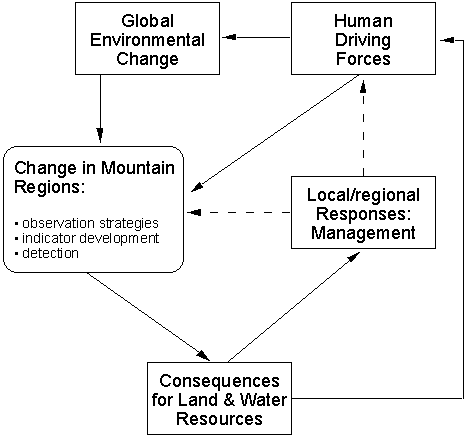The IGBP Initiative on Global Change Research in Mountain Regions is based on an integrated approach for observing (detecting, monitoring), modelling and investigating global change phenomena and processes in mountain regions, including their impacts on ecosystems and socio-economic systems. Both environmental aspects - in particular land use/land cover changes, atmospheric and climatic changes - and socio-economic aspects - in particular social, economic, and political driving forces and changes - as well as their complex interactions and interdependencies will be taken into account.
The objectives of the Mountain Research Initiative are:
1) to develop a strategy for detecting impacts of global environmental change on mountain environments;
2) to define the consequences of global environmental change for mountain regions as well as the downstream lowland systems dependent on mountain resources; and
3) to develop sustainable land, water, and resource management strategies for mountain regions at local to regional scales.
The emphasis of the first objective is on monitoring change in the biophysical environment, and on understanding the interacting ecological and hydrological processes in mountain regions, both with and without local human interference, along altitudinal and other gradients (e.g., land use). Such work recognizes the unique value of many mountain ecosystems that have been and remain relatively uninfluenced by direct human activities, especially in protected areas such as parks and biosphere reserves. The aim of this objective is to develop a network of observation sites in mountains to serve as an ‘early warning’ system for detecting global change impacts.
The emphasis of the second objective is to increase our understanding of the consequences of global environmental change for people and ecosystems. Credible impact assessments form the baseline for informing policy-makers on issues of global environmental changes at local to global levels (cf. Fig. 1). In addition, information from impact assessments has direct application to policies and strategies for resource management that are implemented at local and regional scales.
The emphasis of the third objective, developing sustainable development strategies, is to define a set of potential human responses to global environmental change implementable at local and regional scales. Scientific results developed under this objective would assist policymakers by indicating the extent of degradation of key mountain resources, and by evaluating interactions between alternative resource management strategies at local and regional scales and trajectories of change generated by globally-scaled factors.
A particular value of the integrated approach described here is the explicit nesting of the evaluation of local and regional management strategies into a broader framework of global processes and impacts (Fig. 1). This approach to integration thus adds value to the well-developed theories and practices that fall under the rubric of ‘environment and development’ studies by embedding them in a global context.
Research-based knowledge on past landscape development can greatly enhance our understanding of current and future conditions. For example, the present-day status of terrestrial ecosystems, glaciers, and areas of permafrost is strongly influenced by the environmental conditions that prevailed years, decades, centuries, or even millennia in the past. Studies of past environmental change in mountains are extremely important and valuable in this context, and they form an excellent basis for reconstructing the associated impacts on ecosystems and humans with a much higher spatial resolution than elsewhere. Processes such as climatic forcing and ecosystem dynamics operate and interact on a wide range of time scales, from individual extreme events to century- and millennial-scale variability. Long-term records of past changes from mountain regions may provide specific types of information needed for a more complete understanding of past global changes at several scales.
Documenting process dynamics on all of these time scales requires a diversity of methods and archives, and understanding the full interplay of processes requires that insights from all these methods be used in conjunction so that the complex reality of mountain ecosystems, as they change through time, is reflected in the synergy between the various scientific approaches used to study them.
Figure 1: Conceptual framework for the integrated study of global environmental change in mountains, emphasizing feedbacks that occur both within a given mountain region (inner loop) as well as at the global scale (outer loop).
